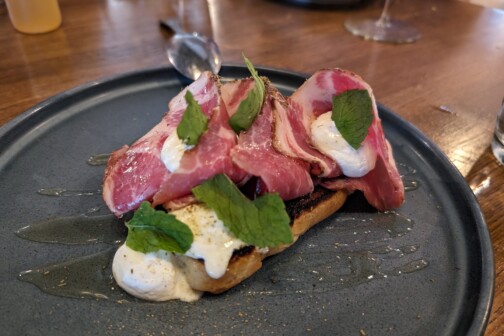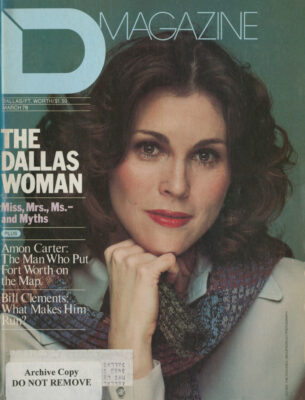Every month, as D Magazine readers well know, more and more restaurants open, adding to the variety and
excitement of an evening on the town. There are so many new ones – and so many great old stand-bys – that it’s hard
to keep track of them. That’s why D Magazine publishes its twice-yearly pull-out supplement, in which
advertisers get a special opportunity to show you what they’ve got to offer.
This spring’s Official D Magazine Restaurant Guide gives you the whole range of cuisine – from tacos to egg
rolls, from escargots to barbecue. We’ve also included some hints to the diner about wines and spirits, calling on
the authority of connoisseur Victor Wdowiak.
Victor Wdowiak, one of Dallas’ most knowledgeable connoisseurs, has from time to time given D Magazine
readers the benefit of his expertise. Here are Victor’s responses to questions people often ask him about wines
and spirits.
I’ve noticed a lot of wines lately from countries I didn’t know even made wines – at least I hadn’t noticed them
in the stores and on menus until just recently. Are they any good?
Yes, some very pleasant wines were imported from such places as Australia, South Africa, and Argentina during the
so-called wine shortage of the past few years. Most of them are good buys today and will become the collector’s
items of the future – their availability will wane over the next decade as the wine industry becomes increasingly
dominated by California and France. We will soon be discussing the relative merits of the Napa, Sonoma, and Monterey
wines of California in the same way that we are weighing the virtues of St. Julien, Margaux, and St. Emilion today.
As the California wines get better and better, there will be very little room in the market place for the spirits of
Argentina.
Do vintages matter in California wines?
Great question. Yes, contrary to the claims of the California Wine Institute and California Chamber of Commerce, the
weather is changeable and vintages vary from year to year. For example, the very best years in Napa were
1951,1958,1961,1965,1968,1970, and 1974.
Are there any blunders of wine etiquette that you would consider the cardinal sins?
I don’t know about cardinal sins, but let me mention two of my pet peeves – two ghastly mistakes made all too often
in Dallas restaurants. I insist on having my wine served before the main course is on the table, not with the main
course or halfway through the meal as, alas, will happen if you do not make a point of it. I am also appalled when a
waiter picks up my glass to refill it.
A waiter in a Dallas restaurant turned our bottle upside down for a few seconds before attempting to remove the
cork. When I asked him why, he explained that this moistens the cork so that it is easier to remove, less likely to
split or crumble. Is this true?
Your waiter would have to stand at your table for a month holding the bottle upside down before there would be any
appreciable absorption by the cork. Besides, if the bottle is properly stored (on its side) the cork will not become
brittle in the first place.
What wine should we order with Chinese food?
Best choices are the almost sweet, light Moselles. There is also a semi-sweet white Bordeaux cleverly merchandised
by Sichel under the name of Wan Fu with a Chinese back label – despite the trickery, it’s a good selection. With a
true Mandarin style dinner with courses served one at a time, the old maxim of white with white and red with red
still holds true. (But my personal choice with Chinese food is the Japanese beer Kirin.)
I’ve heard of the “Winegate” scandal in Bordeaux. Are there certain labels we should avoid?
Much ado about nothing. Under the economic pressure of a sudden increase in demand, some large reputable Bordeaux
houses thought they were caught with insufficient stock. They stretched the letter of the law of wine
regulations a bit and brought in wines from other districts to blend with their own to increase the supply. As it
happens, the resultant blended wines were excellent, but, for political reasons, these firms were made the scapegoat
of the industry and at present are on the verge of bankruptcy. The company most talked about was Cruse; for decades
Cruse has supplied us with consistently fine wines and their wines should be (and are) still imported with complete
confidence.
Wines in restaurants are so obviously overpriced. Do restaurants follow any sort of standard markup rates or
regulations?
No, a restaurant may charge whatever they want to for their wines; and you’re right – most of the markups are
ridiculous. Perhaps the high markup places who sell very little wine should take a hint from the places who charge
reasonable prices and sell cases of wine every night.
I’m confused. What is the difference between a claret and a Bordeaux?
A claret is a red Bordeaux (red only, not white). The name “claret” was originally used by the English. It
seems that in the early 1700’s the red Bordeaux was very pale, almost a rose. The French talked of it as “clairet”
meaning “light,” which the English misconstrued into “claret.” (Incidentally, the “t” in claret is pronounced, not
silent as if it were the French word as it is so commonly mispronounced.) Oddly enough, a rose is just beginning to
be produced again in Bordeaux and is being called a “clairet,” which should befuddle the English even more.
While we were visiting Germany we were served white wines that weren’t chilled – they were cool but really almost
room temperature. Why is that?
Delicate light German wines taste best at cellar temperature (about 55-60° F.); chilling them to 45-50° distorts
the real taste. But if you’re in doubt about the quality of your white wine, chill the heck out of it and no one
will ever know how bad it was.
What’s the difference between brandy and cognac?
It seems that one cannot write even a few words about cognac without repeating, ad nauseam, that worn out cliche:
“Not all brandies are cognacs, but all cognacs are brandies.” But alas, nothing else gives a better explanation!
“Brandy” is a word describing the product derived from the distilling of wine; “Cognac” is a geographical name – a
town near the southwestern Atlantic coast of France – and indicates the brandy of that particular region.
It is utter nonsense to discuss in hushed, reverent tones the Napoleonic brandies – and there is one in every crowd
who wants to. Please! There is no such thing. If a bad brandy was bottled in 1812, it would be a disaster today. And
even if you could find a great cognac bottled during Bonaparte’s life, it would also be spoiled by now.
There are no vintage cognacs produced anymore. The practice was impossible to control and the results were not
always wondrous. There is no law dictating how the quality of cognac should be described on the label. Confusion
reigns: some firms use stars (more stars mean older or better), others use initials like V.S.O.P. or X.O. The latest
trend is to use an impressive trademark or nickname like Hennessy’s “Bras Armé” or Remy-Martin’s “Louis XIII.”
A great cognac should have a striking, lovely aroma without the help ofheat, though the inferior cognacs needall the
help you can give them, including the infamous brandy warmer. Thedrinking glass used by cognac makers(who should
know best) is a sniftertype that easily fits in the palm of your hand.
Get our weekly recap
Brings new meaning to the phrase Sunday Funday. No spam, ever.
Related Articles

Local News
Mayor Eric Johnson’s Revisionist History
In February, several of the mayor's colleagues cited the fractured relationship between City Manager T.C. Broadnax and Johnson as a reason for the city's chief executive to resign. The mayor is now peddling a different narrative.

Media
Will Evans Is Now Legit
The founder of Deep Vellum gets his flowers in the New York Times. But can I quibble?
By Tim Rogers

Restaurant Reviews
You Need to Try the Sunday Brunch at Petra and the Beast
Expect savory buns, super-tender fried chicken, slabs of smoked pork, and light cocktails at the acclaimed restaurant’s new Sunday brunch service.


